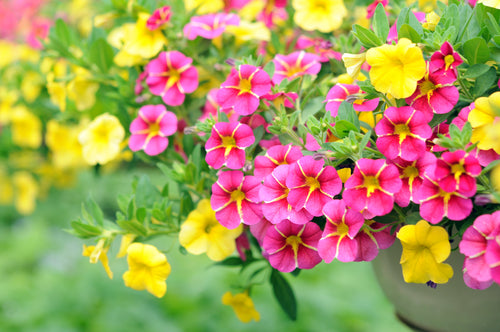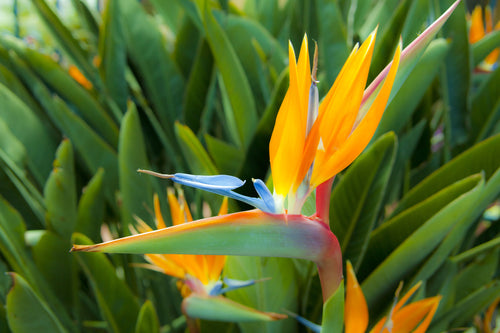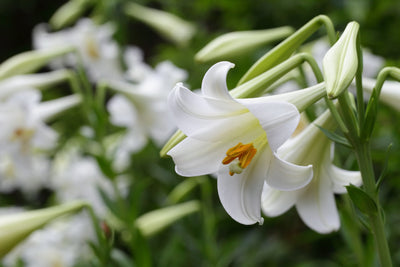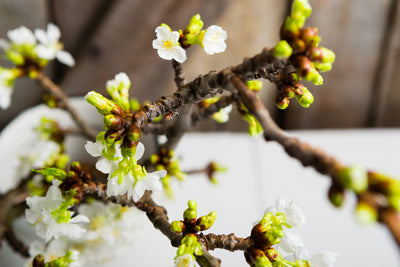Understand the life cycle of grubs and you’ll know if you have a problem, treatment type and application time.
The white grub is the larval form of a scarab beetle, such as the European chafer or Japanese beetle. Grubs feed on plant roots, the damage is apparent when the turf dries up in irregular patterns. Consider browning of turf could also be from drought, poor soil or disease. Check for grubs by lifting the sod in damaged areas, grubs will be in the root zone. A population of 8 to 12 grubs per square foot causes damages that require control. Small populations of grubs may attract skunks and raccoons which will dig in various areas searching for a meal.
Remember every grub season may be different because of weather and soil temperature. On average in late June and early July, Japanese beetle adults emerge from the ground in search of food and mates.
Adults feed on a multitude of plants; some favorites are petunias, Japanese maples, roses, grapes, linden trees, green beans, etc, etc. Beetles can travel over a mile in search of food and mates.
During July, female beetles spend 2-3 weeks laying up to 60 eggs in the soil. Again, depending in the weather eggs hatch about 2 weeks later.
The first stage (first instar), grubs feed on grass roots through August. The small grubs feeding near the surface can be controlled by conventional and natural/organic treatments. Apply controls before increased root damage is noticeable. Late August through October (Remember weather controls the cycle) grubs molt into a second and third stage. Grubs drop down in soil over winter below the frost line. As soil warms in spring, grubs return to the surface and start eating roots again. Late spring grubs stop feeding and begin pupatating. Mid June and early July beetles emerge and the cycle starts again.
Conventional Treatments
Bayer 24 Hour Grub Killer Plus
Chemical Name: Trichlorfon 6.2% or Dylox
For Best Results: The best time to kill grubs is July through September when they are young and actively feeding near the soil surface.
- Water with no more than 1/2 inch within 24 hours of applying.
- Do not mow until the granules are watered into the soil.
- Avoid applying this product to water logged areas, as this may decrease the products effectiveness.
- You may spread this product over the soil or mulch. If present, remove weed barrier before applying.
- Note: This product is intended to be used when grubs are present. After granules are watered in, insects are killed on contact. The active ingredient degrades quickly.
Grubs that are controlled by Dylox will not just disappear. They stop doing damage but take a while to fully die and decompose. You might still see grubs in the area or damage to turf from skunks and raccoons. This does not mean that it’s not working!
For More Information:
1–877–229–3724
http://www.bayeradvanced.com
Scott’s Grubex
Chemical Name: Chlorantraniliprole .2%
For Best Results: Grubex works best when applied before grubs hatch. The active ingredient will remain in the root zone of the turf with the eggs til grubs hatch. These newly hatched insects are highly susceptible to Grubex and are killed before large enough to cause turf damage.
Application time in our area because of weather conditions should be last of June, early July. Remember, Grubex takes 10 days to move into grass roots! Do not use in the vegetable garden!!
Grubex will work best if material is worked into the soil around plants or if a thorough watering or rainfall occurs within 24 hours after application to move product down through mulch and into the soil.
Questions/Information
1–800–543–8873
http://www.scotts.com
Pesche’s Natural/Organic Grub Treatments
Nema™ Globe Nematodes Grub Busters®
Use: Beneficial Nematodes (BN) attack more than 230 kinds of soil dwelling and wood boring pests, such as flea larvae, white grubs (European chafer, Japanese beetle and June beetle), cutworms, corn root worms, strawberry weevils, gypsy moth larvae, cabbage root maggots, fungus gnat larvae and many, many more.
Release: BN may be released by spraying with water, mixing with mulch and applying directly to the soil or potting mix or injecting into burrows. They may be used at any time of the year as long as the ground is not frozen. Do not release in direct sunlight as this will kill them. See directions for details.
Coverage: One globe container will cover up to 3,000 square feet but faster results are obtained with higher concentrates.
General Information: Beneficial Nematodes are microscopic in size and cannot be seen with the naked eye. The Nema-globe brand includes Grub Busters® to treat for white grubs in lawns and gardens. Each Nema-globe is applied by simply mixing the nematodes into a Nema-globe Nematode Sprayer and watering into your lawn or garden. There is no extra mixing or handling issues typical of chemical grub control products. Nematodes do not harm pets, children or other beneficial insects like bees or earthworms.
Grub Busters Grub Eliminator contain the toughest nematodes on the planet based on the Steinernema glaseri nematode strain. The globes are always fresh packed and time dated to ensure consumers receive live nematodes. To round out the rest of the Nema-globe line-up is a pre-calibrated nematode sprayer.
http://www.environmentalfactor.com
Milky Spore by St. Gabriel Laboratories
Active Ingredients: Bacillus Popilliae .02%
Where to use: Lawns, flower beds, ground covers and around trees and shrubs.
When to use: Milky Spore is a 2–year program. Apply Spring, Summer and Fall for 2 consecutive years.
How it works: Milky Spore is a nodual bacteria that stays dormant in the soil. When grubs begin feeding they ingest the bacteria. The bacteria begin to multiply inside the grub consuming it. Once the grub begins to decay, more spore is released into the soil.
This product is composed of Milky Spore in a granular carrier designed to deliver a biological control for white grubs of Japanese beetles in lawns, gardens and flower beds. Milky Spore is a natural insect pathogen that causes an illness in beetle larvae, yet, it is not known to harm man, plants or beneficial insects. For best results, use this product once each season for three years to allow a maximum buildup of Milky Spore in the soil. Effective control will then occur and continue on their own for several years.
For questions or comments, call toll free (800–801–0061)













